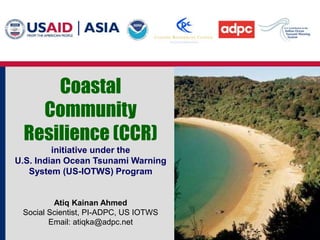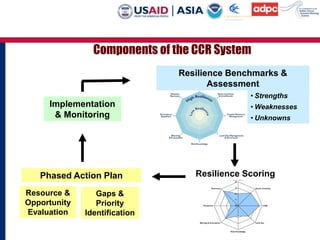d1s3_ccr_overview.ppt
- 1. Coastal Community Resilience (CCR) initiative under the U.S. Indian Ocean Tsunami Warning System (US-IOTWS) Program Atiq Kainan Ahmed Social Scientist, PI-ADPC, US IOTWS Email: atiqka@adpc.net
- 2. Absorb shock Bounce back Learning/adaptation
- 3. The Context for Coastal Disasters âĒ Coastal populations dramatically increasing (leading towards more demographic vulnerabilities) âĒ Climate change is anticipated to increase the coastal hazard threat trends (sea level rise, floods, storm â both intensity & frequency) âĒ New problems of âmega disastersâ emerging âĒ Disasters are undermining years of development efforts âĒ Increase in anthropogenic and human induced vulnerabilities
- 4. The Hyogo Framework for Actions (HFA) -2005-2015 has increased the focus on building community resilience for disaster management An Increased focus on Community Resilience
- 5. Defining âResilienceâ âthe potential of a particular configuration of a system to: maintain its structure/function in the face of disturbance, and the ability of the system to re-organize following disturbance-driven change . . . (Louis Lebel, 2001) âthe capacity to survive, adapt and recover from a natural disaster. (IFRC, 2004)
- 6. Godschalk (2003) âĒ redundancy âĒ diversity âĒ efficiency âĒ autonomy âĒ strength âĒ interdependence âĒ adaptability âĒ collaboration
- 7. Goals of coastal community resilience
- 9. Elements of Coastal Community Resilience
- 10. Governance ïģ Leadership, systems, and institutions appropriate to the community that support actions to promote resilience
- 11. Socio-economy and Livelihoods ïģ Prosperous, sustainable, diverse economies and livelihoods that allow communities to help themselves before, during, and after disasters
- 12. Coastal Resources Management ïģ Active management of renewable resources and protection of habitat and features that sustain those resources and buffer communities from natural disasters
- 13. Land Use Management and Structures ïģ Active management of land uses in the community that allow development to be directed away from environmentally sensitive and vulnerable areas
- 14. ïģ Zoning, building codes, and infrastructure development guidelines that reduce exposure to coastal natural disaster risks
- 15. Risks Knowledge ïģ An understanding of risks from coastal natural disasters a community faces and its vulnerability to disasters
- 16. Warning and Evacuation ïģ Ability to receive alerts and notifications of coastal hazards and to warn and evacuate at-risk populations
- 17. Emergency Response and Disaster Recovery ïģ Ability of community to mobilize to manage coastal disasters with minimal dependence on outside assistance ïģ Ability of a community to manage post- disaster assistance
- 18. Components of the CCR System Resilience Benchmarks & Assessment âĒ Strengths âĒ Weaknesses âĒ Unknowns Gaps & Priority Identification Resource & Opportunity Evaluation Phased Action Plan 0 1 2 3 4 Governance Socio-economy CRM Land Use Risk Knowledge Warning & Evacuation Response Recovery Resilience Scoring Implementation & Monitoring
- 20. Old Model HFA Disaster Management Groups Technological Warning Groups Ecological and Environmental Groups Disaster Mang. Warning CRM Isolated community focus E. g. IFRC E.g. IOC IOTWS E. g. WWF
- 21. Ideal State HFA Disaster Management Groups Technological Warning Groups Ecological and Environmental Groups Community resilience Governance Socio-economy & Livelihoods Coastal Resource Management Land Use Management & Structures Risk Knowledge Warning & Evacuation Emergency Response Disaster Recovery E. g. IFRC E.g. US IOTWS E. g. WWF CCR Framework Integrated DRR and resilience building at community level
- 22. National workshops and partnering Indonesia - September, 2006. Community level field testing Evolving CCR initiativesâĶ. Concept development Training and capacity material development National training and capacity development of partners Sri Lanka â October, 2006. Regional workshop Regional workshop and dissemination India (Tamil Nadu) â Nov, 2006 Thailand (Ranong) â Dec, 2006 Guidebook development Capacity development of national partners Sharing of implementation experiences by the partners Sri Lanka & Indonesia - Feb-March, 2007.
- 23. Thanks!























